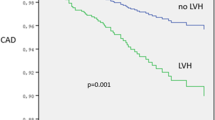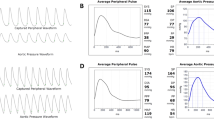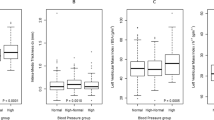Abstract
Left ventricular hypertrophy (LVH) is prognostically relevant, associated with major cardiovascular risk factors and with atherosclerosis. However, whether LVH is independently associated with impaired coronary flow reserve (CFR) and with endothelial dysfunction is disputed. We assessed the relationship of LV mass and systolic function to CFR and endothelial function in new discovered never treated subjects with essential arterial hypertension, but without coronary artery disease or microalbuminuria. LVH, ejection fraction (EF) and stress-corrected midwall shortening (MWS, a measure of myocardial contractility) were assessed by echocardiography. CFR was assessed by single-photon emission computed tomography and dipyridamole infusion. Endothelial function was evaluated by assessing 1-min postischaemic flow-mediated dilatation of the brachial artery (FMD); nitroglycerine-mediated dilatation (NMD) of the same brachial artery was used as measure of nonendothelium-dependent vasodilatation. In approximately 1 year, we enrolled 21 subjects who met stringent inclusion criteria (47±10 years old, 26.6±2.8 kg/m2, 78% men). Five patients showed LVH. Multivariate analyses showed a significant negative correlation of LV mass index with FMD (β=−0.61, P<0.05) but not with NMD, neither with CFR. Stress-corrected MWS showed independent correlation with CFR (β=0.51, P<0.05). Thus, in clinically healthy, new discovered hypertensive subjects, never treated and mostly in the early stage of arterial hypertension, LVH can be associated with endothelial dysfunction while maximal dipyridamole- dependent CFR may be preserved; nevertheless, a cardiac phenotype presenting with tendency to impaired myocardial contractility, assessed by stress-corrected MWS, showed association with lower CFR in the early stage of arterial hypertension.
This is a preview of subscription content, access via your institution
Access options
Subscribe to this journal
Receive 12 digital issues and online access to articles
$119.00 per year
only $9.92 per issue
Buy this article
- Purchase on Springer Link
- Instant access to full article PDF
Prices may be subject to local taxes which are calculated during checkout



Similar content being viewed by others
References
Vakili BA, Okin PM, Devereux RB . Prognostic implications of left ventricular hypertrophy. Am Heart J 2001; 141: 334–341.
de Simone G et al. Midwall left ventricular mechanics. An independent predictor of cardiovascular risk in arterial hypertension. Circulation 1996; 93: 259–265.
de Simone G et al. Association of left ventricular hypertrophy with metabolic risk factors: the HyperGEN study. J Hypertens 2002; 20: 323–331.
Celermajer DS et al. Non-invasive detection of endothelial dysfunction in children and adults at risk of atherosclerosis. Lancet 1992; 340: 1111–1115.
Leschke M et al. Reduced peripheral and coronary vasomotion in systemic hypertension. Eur Heart J 1992; 13 (Suppl D): 96–99.
Likoff W, Segal BL, Kasparian H . Paradox of normal selective coronary arteriograms in patients considered to have unmistakable coronary heart disease. N Engl J Med 1967; 276: 1063–1067.
Strauer BE . Ventricular function and coronary hemodynamics in hypertensive heart disease. Am J Cardiol 1979; 44: 999–1006.
Wangler RD, Peters KG, Marcus ML, Tomanek RJ . Effects of duration and severity of arterial hypertension and cardiac hypertrophy on coronary vasodilator reserve. Circ Res 1982; 51: 10–18.
Marcus ML et al. Abnormalities in the coronary circulation that occur as a consequence of cardiac hypertrophy. Am J Med 1983; 75: 62–66.
Opherk D et al. Reduction of coronary reserve: a mechanism for angina pectoris in patients with arterial hypertension and normal coronary arteries. Circulation 1984; 69: 1–7.
Vogt M, Motz W, Strauer BE . Coronary haemodynamics in hypertensive heart disease. Eur Heart J 1992; 13 (Suppl D): 44–49.
Strauer BE . Myocardial oxygen consumption in chronic heart disease: role of wall stress, hypertrophy and coronary reserve. Am J Cardiol 1979; 44: 730–740.
Brush Jr JE et al. Angina due to coronary microvascular disease in hypertensive patients without left ventricular hypertrophy. N Engl J Med 1988; 319: 1302–1307.
Houghton JL et al. Relations among impaired coronary flow reserve, left ventricular hypertrophy and thallium perfusion defects in hypertensive patients without obstructive coronary artery disease. J Am Coll Cardiol 1990; 15: 43–51.
Parodi O et al. Comparative effects of enalapril and verapamil on myocardial blood flow in systemic hypertension. Circulation 1997; 96: 864–873.
Palombo C et al. Early impairment of coronary flow reserve and increase in minimum coronary resistance in borderline hypertensive patients. J Hypertens 2000; 18: 453–459.
Gimelli A et al. Homogeneously reduced versus regionally impaired myocardial blood flow in hypertensive patients: two different patterns of myocardial perfusion associated with degree of hypertrophy. J Am Coll Cardiol 1998; 31: 366–373.
Palmieri V et al. Echocardiographic wall motion abnormalities in hypertensive patients with electrocardiographic left ventricular hypertrophy: the LIFE Study. Hypertension 2003; 41: 75–82.
Alberti KG, Zimmet PZ . Definition, diagnosis and classification of diabetes mellitus and its complications. Part 1: diagnosis and classification of diabetes mellitus. Provisional report of a WHO consultation. Diabet Med 1998; 15: 539–553.
Palmieri V et al. Reliability of echocardiographic assessment of left ventricular structure and function: the PRESERVE study. J Am Coll Cardiol 1999; 34: 1625–1632.
Schiller NB et al. Recommendations for quantitation of the left ventricle by two-dimensional echocardiography. American Society of Echocardiography Committee on Standards, Subcommittee on Quantitation of Two-Dimensional Echocardiograms. J Am Soc Echocardiogr 1989; 2: 358–367.
Sahn DJ, DeMaria A, Kisslo J, Weyman A . Recommendations regarding quantitation in M-mode echocardiography: results of a survey of echocardiographic measurements. Circulation 1978; 58: 1072–1083.
Devereux RB et al. Echocardiographic assessment of left ventricular hypertrophy: comparison to necropsy findings. Am J Cardiol 1986; 57: 450–458.
de Simone G et al. Assessment of left ventricular function by the midwall fractional shortening/end-systolic stress relation in human hypertension [erratum in J Am Coll Cardiol 1994 Sep; 24(3): 844]. J Am Coll Cardiol 1994; 23: 1444–1451.
Gaasch WH et al. Stress-shortening relations and myocardial blood flow in compensated and failing canine hearts with pressure-overload hypertrophy. Circulation 1989; 79: 872–883.
Shimizu G et al. Left ventricular midwall mechanics in systemic arterial hypertension. Myocardial function is depressed in pressure-overload hypertrophy. Circulation 1991; 83: 1676–1684.
Palmieri EA et al. Aerobic exercise performance correlates with post-ischemic flow-mediated dilation of the brachial artery in young healthy men. Eur J Appl Physiol 2005; 94: 113–117.
Corretti MC et al. Guidelines for the ultrasound assessment of endothelial-dependent flow-mediated vasodilation of the brachial artery: a report of the International Brachial Artery Reactivity Task Force. J Am Coll Cardiol 2002; 39: 257–265.
Joannides R et al. Nitric oxide is responsible for flow-dependent dilatation of human peripheral conduit arteries in vivo. Circulation 1995; 91: 1314–1319.
Vogel RA, Corretti MC, Plotnick GD . A comparison of brachial artery flow-mediated vasodilation using upper and lower arm arterial occlusion in subjects with and without coronary risk factors. Clin Cardiol 2000; 23: 571–575.
Sugihara H et al. Estimation of coronary flow reserve with the use of dynamic planar and SPECT images of Tc-99 m tetrofosmin. J Nucl Cardiol 2001; 8: 575–579.
Storto G et al. Estimation of coronary flow reserve by Tc-99 m sestamibi imaging in patients with coronary artery disease: comparison with the results of intracoronary Doppler technique. J Nucl Cardiol 2004; 11 (6): 682–688.
Roman MJ et al. Association of carotid atherosclerosis and left ventricular hypertrophy. J Am Coll Cardiol 1995; 25: 83–90.
Devereux RB et al. Relation of left ventricular midwall function to cardiovascular risk factors and arterial structure and function. Hypertension 1998; 31: 929–936.
Sasaki O, Hamada M, Hiwada K . Effects of coronary blood flow on left ventricular function in essential hypertensive patients. Hypertens Res 2000; 23: 239–245.
Schwartzkopff B et al. Structural and functional alterations of the intramyocardial coronary arterioles in patients with arterial hypertension. Circulation 1993; 88: 993–1003.
Widlansky ME, Gokce N, Keaney Jr JF, Vita JA . The clinical implications of endothelial dysfunction. J Am Coll Cardiol 2003; 42: 1149–1160.
Gokce N et al. Predictive value of noninvasively determined endothelial dysfunction for long-term cardiovascular events in patients with peripheral vascular disease. J Am Coll Cardiol 2003; 41: 1769–1775.
Ghiadoni L et al. Endothelial function and common carotid artery wall thickening in patients with essential hypertension. Hypertension 1998; 32: 25–32.
Muiesan ML et al. Flow-mediated dilatation of the brachial artery and left ventricular geometry in hypertensive patients. J Hypertens 2001; 19: 641–647.
Perticone F et al. Relationship between left ventricular mass and endothelium-dependent vasodilation in never-treated hypertensive patients. Circulation 1999; 99: 1991–1996.
Kozakova M et al. Coronary vasodilator capacity and epicardial vessel remodeling in physiological and hypertensive hypertrophy. Hypertension 2000; 36: 343–349.
Galderisi M et al. Coronary flow reserve in hypertensive patients with appropriate or inappropriate left ventricular mass. J Hypertens 2003; 21: 2183–2188.
Marcus ML et al. Alterations in the coronary circulation in hypertrophied ventricles. Circulation 1987; 75: I19–I25.
Olsen MH et al. Association between vascular dysfunction and reduced myocardial flow reserve in patients with hypertension: a LIFE substudy. J Hum Hypertens 2004; 18 (6): 445–452.
Motz W et al. Evidence of endothelial dysfunction in coronary resistance vessels in patients with angina pectoris and normal coronary angiograms. Am J Cardiol 1991; 68: 996–1003.
Quyyumi AA et al. Contribution of nitric oxide to metabolic coronary vasodilation in the human heart. Circulation 1995; 92: 320–326.
Acknowledgements
This work was supported in part by the PhD Educational Grant, ‘Dottorato di Ricerca in Patologia e Clinica della Malattie cronico-degenerative del sistema cardiovascolare, reumatologiche e della nutrizione’—XVI ciclo, Dipartimento di Medicina Clinica e Sperimentale. Università ‘Federico II’, Napoli.
Author information
Authors and Affiliations
Corresponding author
Additional information
Conflict of interest: None.
Rights and permissions
About this article
Cite this article
Palmieri, V., Storto, G., Arezzi, E. et al. Relations of left ventricular mass and systolic function to endothelial function and coronary flow reserve in healthy, new discovered hypertensive subjects. J Hum Hypertens 19, 941–950 (2005). https://doi.org/10.1038/sj.jhh.1001921
Received:
Revised:
Accepted:
Published:
Issue Date:
DOI: https://doi.org/10.1038/sj.jhh.1001921
Keywords
This article is cited by
-
Impaired Flow-Mediated Vasodilatation Is Associated With Increased Left Ventricular Mass in a Multiethnic Population. The Northern Manhattan Study
American Journal of Hypertension (2010)
-
Assessment of the arterial input function for estimation of coronary flow reserve by single photon emission computed tomography: comparison of two different approaches
European Journal of Nuclear Medicine and Molecular Imaging (2009)



